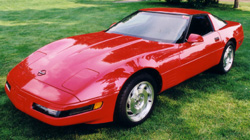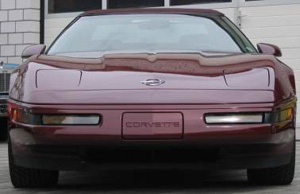
Corvette celebrated its 40th Anniversary in 1993 and marked the milestone with a one-year-only special appearance package. This well thought out add-on included special "Ruby Red" exterior finish, matching interior trim, color-keyed wheel centers, unique headrest embroidery and specific bright emblems on the hood, deck and body side “gills.” The $1,455 anniversary package was optional equipment on the Corvette hatchback and convertible, as well as on cars with the high-performance ZR-1 kit.
As usual, Corvette prices for 1993 increased a bit, climbing nearly $1,000. The hatchback listed for $34,595 and the convertible for $41,195. The world-class ZR-1 hatchback went out the door for $66,278. In the same order, the .Vette models weighed in at 3,333 lbs., 3,383 lbs. and 3,503 lbs., respectively Chevy ultimately built 15,898 hatchbacks and 5,712 ragtops in the model year. Just 448 of the hatchbacks were fitted with ZR-1 equipment. The 40th Anniversary package — code Z25 — was installed on 6,749 cars and adds extra value today. It is popular with Corvette collectors.
The 1993 ‘Vettes introduced GM's first Passive Keyless Entry system whereby simply leaving or approaching the care automatically unlocked or locked the appropriate door. It was also the first North American automobile to use recycled sheet-molded-compound body panels.
The 1993 ZR-1 was upgraded and had a hotter 5.7-liter LT-5 V-8 with significant horsepower and torque increases. Improved air flow from the cylinder heads and valve train refinements boosted its factory rating from 375 hp to 405 hp. ZR-1 owners again stirred the gearbox through a six-speed transaxle.
Standard Corvettes used a 5.7-liter V-8, too, but it was the slightly milder LT-1 version and came standard with a four-speed overdrive automatic transmission. A six-speed manual gearbox could be substituted.
Standard features included a removable body-color roof panel for hatchbacks or a convertible top for the rarer body style. All ‘Vette convertibles, except those with the 40th Anniversary Package, could be ordered with a Beige, Black or White cloth top. 40th Anniversary ragtops came only with a Ruby Red cloth top.
For the “matching-numbers” crowd, the Corvette had the standard 17-symbol Vehicle Identification Number. It was visible through the windshield, which can be a problem today. It is possible for thieves to take down the number and get a key made, so covering the number when the car is parked is not a bad idea. Base models used numbers 1G1YY[2 or 3]3PXP5100001 to 1G1YY[2 or 3]3PXP5121142 while ZR-1s were coded 1G1YZ23J3P5800001 to 1G1YZ23J3P5800448.
Not all of the symbols are real important. For example, the country of origin and plant codes are a given with all late-model ‘Vettes. But certain codes should be checked when you are buying a car. The sixth symbol is a 2 for a hatchback or a 3 for a convertible. The eighth symbol indicates engine: P is for the LT1 or J is for the LT5. The 10th symbol is a P for 1993.
The last six symbols in the VIN indicate the sequential production number at the Bowling Green, Kentucky factory and are repeated on the engine block. They appear on a pad just ahead of the cylinder head on the passenger side of the engine. The three-letter suffixes for 1993 were: ZVA for the LT1 with automatic, ZVB for the LT1 with manual transmission and ZVC for the hot LT5.
Paint codes used in 1993 are:(10) Arctic White, (41) Black, (43) Bright Aqua Metallic, (45) Polo Green II Metallic, (53) Competition Yellow, (68) Ruby Red, (70) Torch Red, (73) Black Rose Metallic, (75) Dark Red Metallic and (80) Quasar Blue Metallic. Upholstery codes include (19C) for Black cloth. There are also six leather trims: (103) White, (143) Light Gray, (193) Black, (643) Light Blue, (703) Red and (793) Ruby Red.
Both of the five-main-bearing engines used in ‘Vettes are 90-degree V-8s with hydraulic lifters and multi-port fuel injection. The base engine runs a 10.5:1 compression ratio. It develops: 300 hp at 5000 rpm and 340 lbs.-ft.of torque at 3600 rpm. The ZR-1 mill is special with four valves per cylinder, four overhead cams and an 11.0:1 compression ratio. It is rated 405 hp at 5800 rpm and 385 lbs.-ft. of torque at 5200 rpm.
With a 96.2-in. wheelbase, the ’93 ‘Vette is 178.5 in. long and 70.1 inches wide. The hatchback is 46.3 in. high, compared to 47.3 in. for the convertible. Standard front tires are P255/45ZR15 Goodyear Eagle GTs with P285/40ZR17 Goodyear Eagle GTs at the rear. The ZR-1 uses size P315/35ZR17 at the rear.
Popular ’93 Corvette options included leather sports seats for $1,180, an auxiliary hardtop for the convertible at $1,995, dual removable roof panels for the coupe at $950 and electronic air conditioning control for $205. The FX3 electronic Selective Ride & Handling system was $1,695 extra.. Transmission choices included a six-speed manual transmission as a no-cost option. The ZR1 Special Performance package was technically a $31,683 option for the hatchback coupe. That was considered a hefty option price in 1993.
Any '93 'Vette is a nice car to own and drive. Recent auction prices on these cars include $34,000 for a nice hatchback, $45,000 for a hatchback with the 40th Anniversary package and $60,000 for a ZR-1. We would expect a convertible to drop in at about $42,000. These prices are close to what the cars sold for new, so if you bought one 14 years ago, held on to it and kept it nice, you’re about even. In other words, no depreciation in almost 15 years! Few other cars can say the same thing.